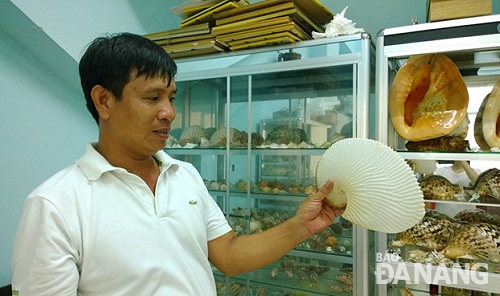Swimming coach shows his love for Viet Nam's seas through his impressive shell collection
Mr Phan Thanh Toai, the Head of the Da Nang Diving and Swimming Club and former coach of local talented swimmer Hoang Quy Phuoc, is famous for his valuable collection of thousands of species of shells. The majority of his shells have been collected over the past 10 years from Viet Nam’s territorial waters.
Mr Toai said he is willing to spend time explaining details of the origin, age and distinctive characteristics of the shells in his collection.
 |
| Mr Toai introducing his favourite shell, an aegonau argo linnaeus |
Visitors are surprised by the eye-catching colours of the shells which are on display around every corner of his working room at the city’s Diving and Swimming Club on 2 September Street. A cabinet in the room, once a place for displaying the trophies, medals and certificates of merit won during his career, is now used to store his shell collection.
Over the past decade he has dramatically increased the number of shells in his collection. He, therefore, cannot remember the exact number on display, but he can accurately identify each species.
His collection features shells ranging in size from as small as a grain of rice to some weighing several kilograms. In particular, some are many times older than the collector.
He remarked that his evaluation and collection of shells is usually based on 2 main criteria: the interesting colours and the distinctive shapes. Therefore, it is interesting to see shells of many different colours such as crystal white, deep emerald-green and pastel pink, and shapes such as leaves, loudspeakers, Buddha’s ears, human hands and teapots.
There are also some species of snails, crabs and spider crabs which are considered to be living fossils in the animal kingdom.
Mr Thoai says that he is willing to donate his whole collection to local museums so that visitors, especially local children, can understand more about the country’s sea and islands through gaining a thorough grasp of the shells on display.